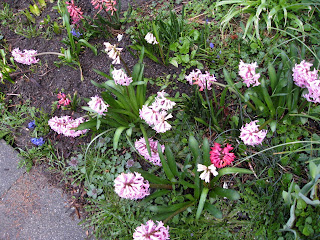Ron calibrating the moisture meter.
When the rains stopped late June and our dry season began we had to start hand watering all of the new beds. The irrigation system in the backyard had been destroyed by all of the construction and earthworks. The irrigation company we wanted to use was booked up for months ahead but they couldn't start anyway until the next phase of construction was underway. We were a bit tardy on getting that next phase of construction going. I was busy focusing on keeping the new soil beds alive with soil building activity.
After a month or so of me leaping out of bed before 7, every third day, to go and hand water all of the new beds for a couple of hours and coming inside with my PJs wet through Ron got into planning mode and set up a temporary irrigation system. It involved multiple timers, different types of hoses and a range of sprinklers.
In some places, the perfect spot for full coverage by the sprinkler was to set it in the middle of a path. Priorities. It took Ron several weeks of shifting sprinklers, gauging water pressure, testing soil moisture with the water meter and fine tuning the timers before the system could run with less attention.
I have drawn up a moisture level plan for each garden bed with different amounts of soil moisture related to the number of hours of sunshine and the type of plants to be planted in each bed. The moisture requiremnets are different in each area which added to the complexity of setting up a manual irrigation system.
As some garden beds filled with plant growth the watering needed to be adjusted and all of the newly planted trees continued to need regular watering of a couple of months. We continued to monitor the system over the whole summer.
This year the rains started again with a sprinkle on August 28th and the irrigation system has been turned to manual. I still need small amounts of water now I am into to fall planting.
We are very pleased we got through the summer without any loss of life and now have beds full of deep rich soil.
Davey Tree Truck full of freshly shredded tree prunings.
Ron made contact with a local Davy Tree company owner who lives near our place. When he has a truck load of good quality shredded trees and prunings he arranges for his truck to swing by our place and dump the load. It is convenient and a cost saving for them and a load of gold for our garden. A win-win situation.
We were finishing off the second mulch pile when the Davy truck came by with a third load this summer.
I must say I am fascinated watching the details of how vehicles work.
This driver displayed impressive driving skills when he backed his large truck in under a tree to dump the load exactly where I wanted it.
Here he is at Control Central with safety vest and ear protectors on. Stabilising legs go down, the cherry-picker hoist is raised, the back door is opened, the tray is raised, the load slides out - all with accompanying different warning signals.
And there it is. I am going to ask Sammy to bring around another load of spent hops from a local brewery to mix into this pile to get it activated and to speed up the breakdown process.
And... I found a very healthy mulberry tree for the Leaf hugelkultur bed - more details about the tree choice later.





















































